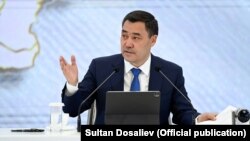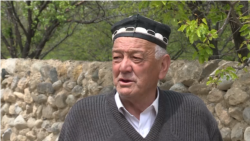Kyrgyz President Sadyr Japarov surprised many at a recent press conference in Bishkek by proposing a land swap with Tajikistan to help resolve a long-standing border dispute.
But it was an offer that Tajikistan could easily refuse -- and the Kyrgyz leader's proposal may have led to increased tensions along an already tense border.
The Kyrgyz-Tajik border -- which meanders through the Pamir Mountains for some 970 kilometers -- didn't really exist until about a century ago.
It has been difficult to demarcate because over the course of some 100 years Soviet mapmakers drew and redrew the Kyrgyz-Tajik border, incorporating land that had traditionally belonged to one people in the territory of the other Soviet republic.
Exclaves appeared and temporary land use agreements were signed.
All of this survived the collapse of the U.S.S.R. and people in Kyrgyzstan and Tajikistan have various Soviet-era maps they use to justify their claim to specific areas along the border.
Only slightly more than half of the frontier has been demarcated, leading to conflicts between rival ethnic communities.
In April, Kyrgyz and Tajik soldiers got involved in a cross-border conflict, with 55 people perishing and hundreds being injured.
It was the first time since the five Central Asian states became independent after the collapse of the Soviet Union in late 1991 that the armies of two of the region's countries had fought each other.
At his October 23 press conference, Japarov spoke about “275 meters” of land that was recognized as Tajik land in a 2009 agreement that also provided for Kyrgyzstan to lease that land for 49 years, saying the land belongs to Kyrgyzstan and he does not accept the 2009 agreement.
The person on the Kyrgyz side who signed that document was Adakhan Madumarov, a long-time politician who in 2009 was the head of Kyrgyzstan’s security council. More recently, Madumarov ran against Japarov in the presidential election in January 2021.
Madumarov responded that the document was a nonbinding agreement and that discussions on the matter were to be continued.
But Japarov said the Tajik side is insisting in talks that the agreement is valid and that land was transferred to Tajikistan in 1924 when it became the Tajik Autonomous Soviet Socialist Republic.
“I answered that, if that is so, in 1924 we handed over Murghab to you, some 3 million hectares. Why don’t you return it to us?”
Japarov said the Tajik side rejected his proposal.
There was really no way Tajikistan could agree to it.
A Small But Significant Town
Besides the huge amount of land involved, the small town of Murghab, with a population of some 16,000, is the largest settlement in northeastern Tajikistan.
Murghab is in Tajikistan’s Gorno-Badakhshan region and a road runs through the town that goes north to Osh in Kyrgyzstan, and south to Khorugh, the capital of Gorno-Badakhshan.
That road is one of only two roads that connect Khorugh to the rest of Tajikistan.
However, the larger region around the town of Murghab going north and northwest has been home to many ethnic Kyrgyz for centuries.

The Tajik government has not made any official response to Japarov’s remarks so far, but the Democratic Party of Tajikistan released a statement on October 26 saying that, since the formation of the Tajik Soviet Socialist Republic, Murghab has been part of Tajikistan’s territory.
Party leader Saidjafar Usmonzoda told RFE/RL’s Tajik Service, known locally as Ozodi, that Japarov’s statement on Murghab amounted to “pressure on Tajikistan in the negotiations on delimitation and demarcation of the state border.”
The comment on returning Murghab received a lot of attention on social media in Tajikistan, much of it predictably negative.
Sherali Rizoyon is a Tajik political commentator who has written extensively about the problems along the Kyrgyz-Tajik border.
In an October 25 post, Rizoyon, unsurprisingly, sided with Tajik authorities in their interpretation of where the border is, writing that the land Kyrgyzstan is leasing for 49 years “never belonged to Kyrgyzstan.”
Rizoyon took issue with Japarov’s statement about scrapping the 2009 agreement, calling it “irresponsible.”
Rizoyon said that, if Japarov intends to cancel the 2009 deal unilaterally, “Tajikistan will be able to rescind all agreements that ‘do not comply with its national interests.’”
Access Issues
Access to farmland and water has increasingly been a problem between the communities along the border and the deadly conflict in April was sparked by an attempt to put monitoring equipment at a small water reservoir used by both countries.
On March 26, barely one month before that deadly fighting, the head of Kyrgyzstan’s State Committee for National Security, Kamchybek Tashiev, proposed that Tajikistan trade its Vorukh exclave for Kyrgyz land.
That prompted Tajik President Emomali Rahmon to make a rare visit to Vorukh on April 7 where he said there had not been and never would be any discussion of transferring the exclave to Kyrgyzstan.
That set the stage for what happened three weeks later.
Japarov said on October 23 that, prior to April 2021, his government had been focusing on talks about border demarcation with Uzbekistan, which has been moving rapidly since Shavkat Mirziyoev became Uzbekistan’s leader in 2016.
“After [negotiations with Uzbekistan] we planned to take up matters concerning the border with Tajikistan,” Japarov said. “Before that I had not studied the documents on the border with Tajikistan.”
Unfortunate Remarks
Japarov’s remarks about Murghab were unfortunate, as they overshadowed some positive recent developments in relations with Tajikistan.
After the conflict in late April, the Kyrgyz-Tajik working group on border issues resumed work.
After the group met in July, they announced the demarcation of an additional 48 kilometers of the border and said they were close to an agreement on 25 more hectares of land.
The working group has been meeting monthly since the April conflict after a halt in talks in recent years.
And in another measure aimed at building better ties between the two countries, Kyrgyz Deputy Prime Minister Edil Baisalov said on October 21 that his country would allow nearly 2,000 Tajik students to return to Kyrgyz universities.
Tajik citizens had been largely unable to enter Kyrgyzstan since the April events.
Many, even in Tajikistan, believe Japarov’s remarks were simply more of his populist rhetoric and an attempt to marginalize Madumarov, something of a political opponent of his.
But all the same, the talk of handing over Murghab is being taken seriously by some in Tajikistan and it will not help promote the de-escalation of tensions along the Kyrgyz-Tajik border.












